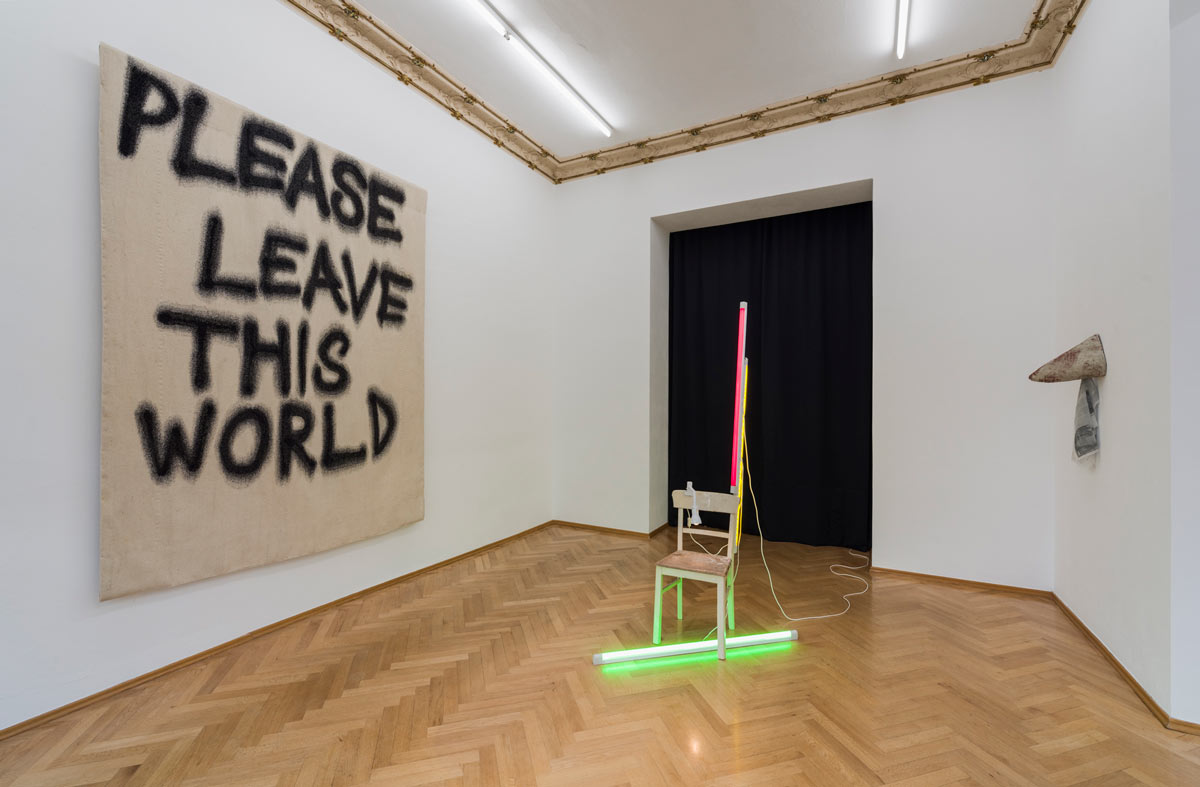
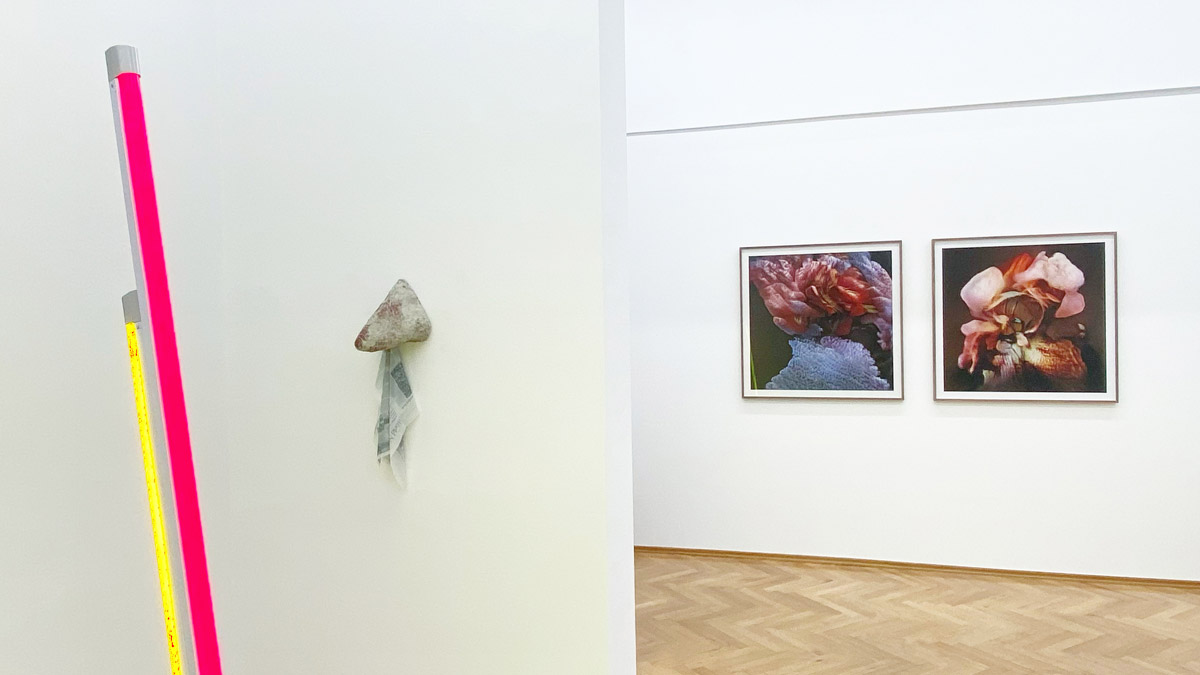
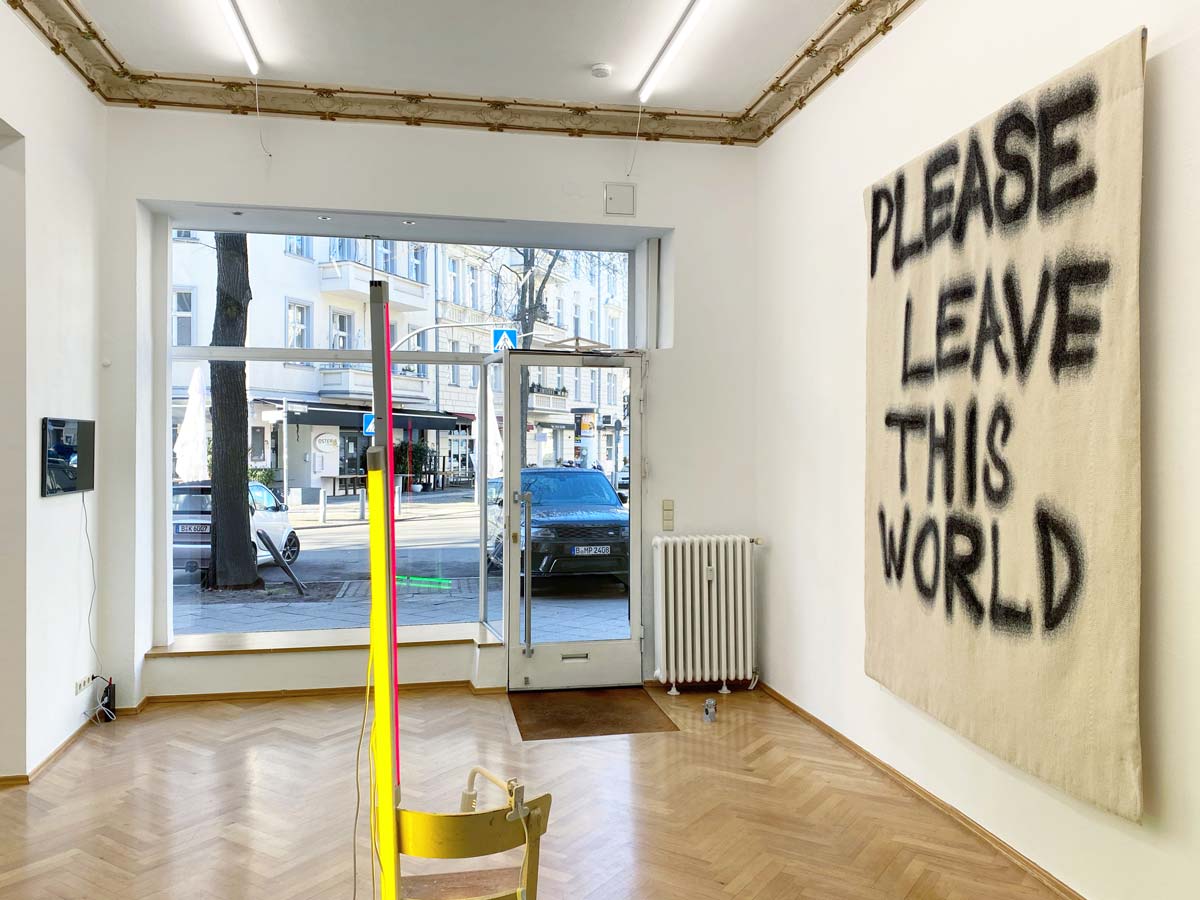
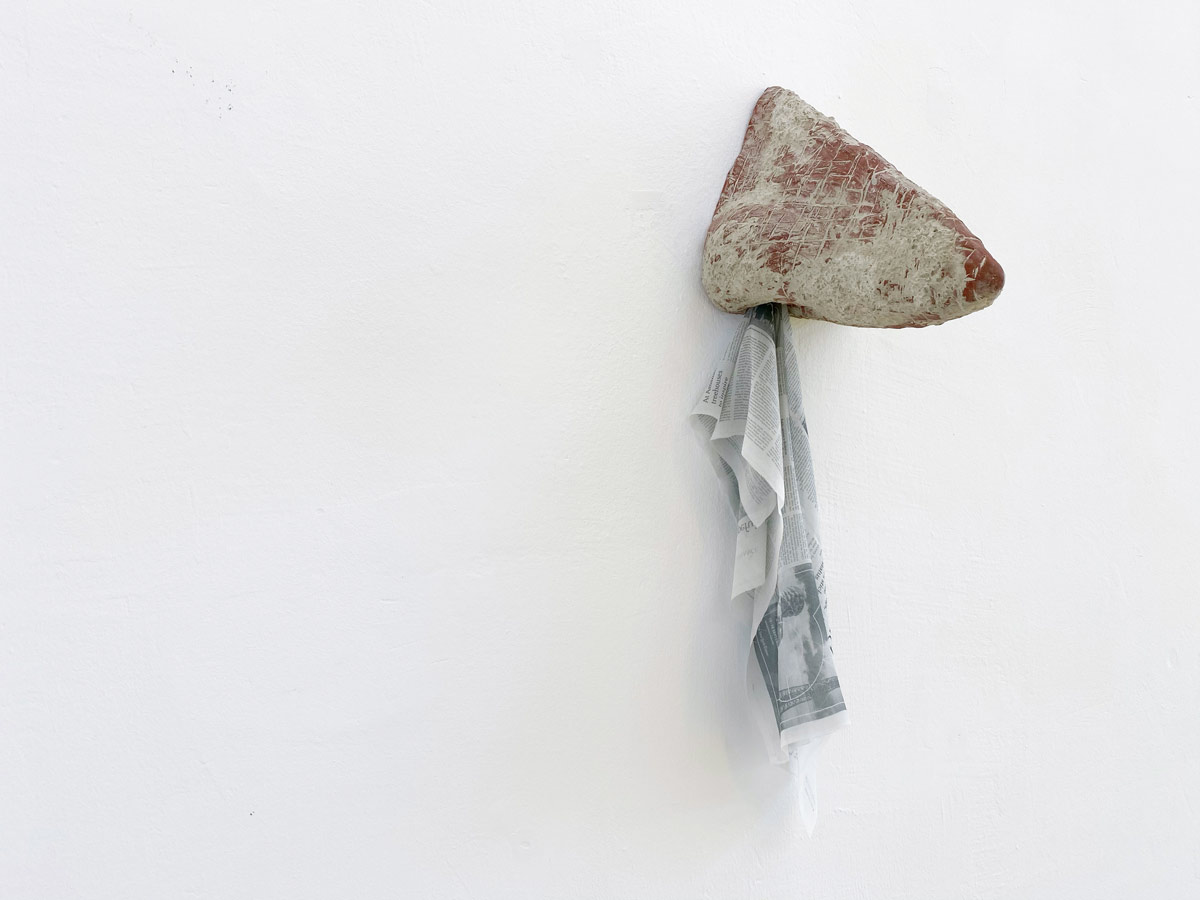
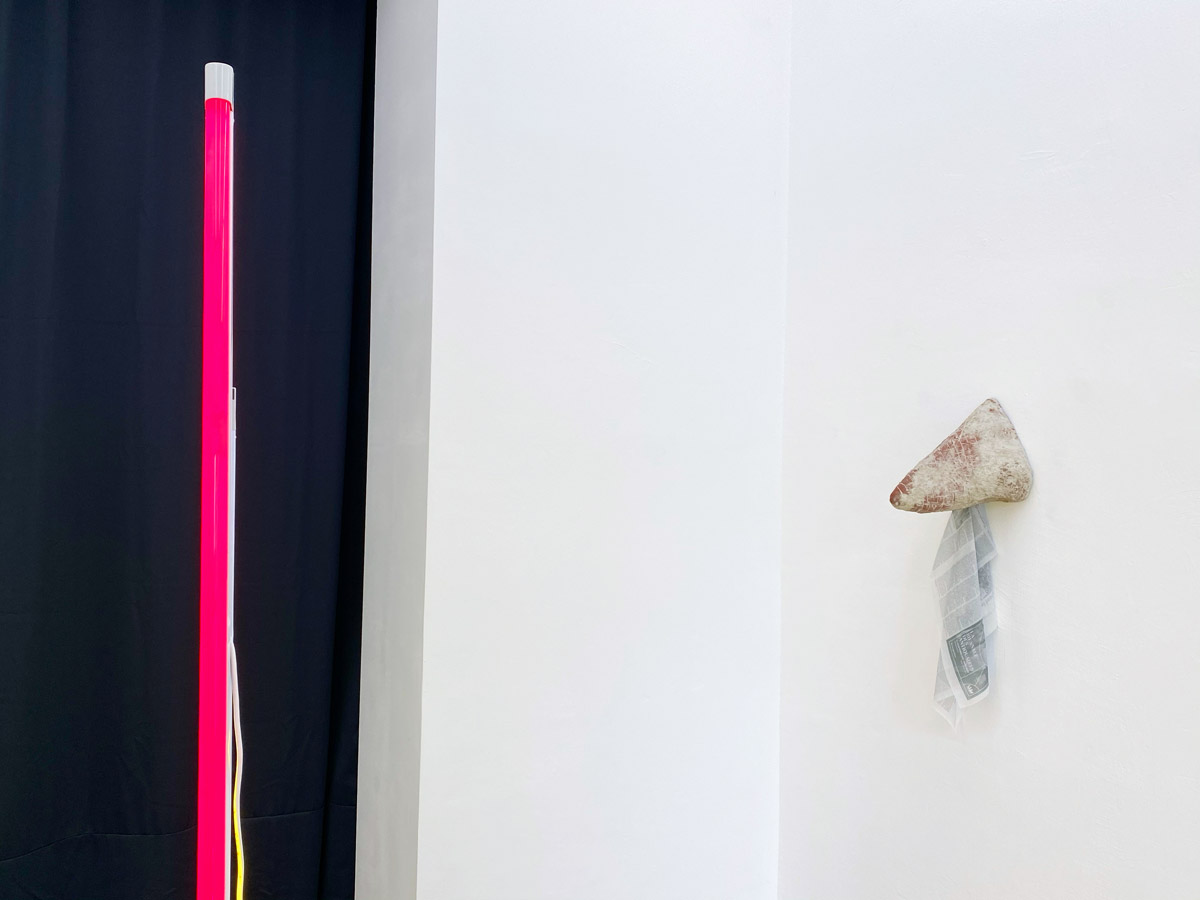
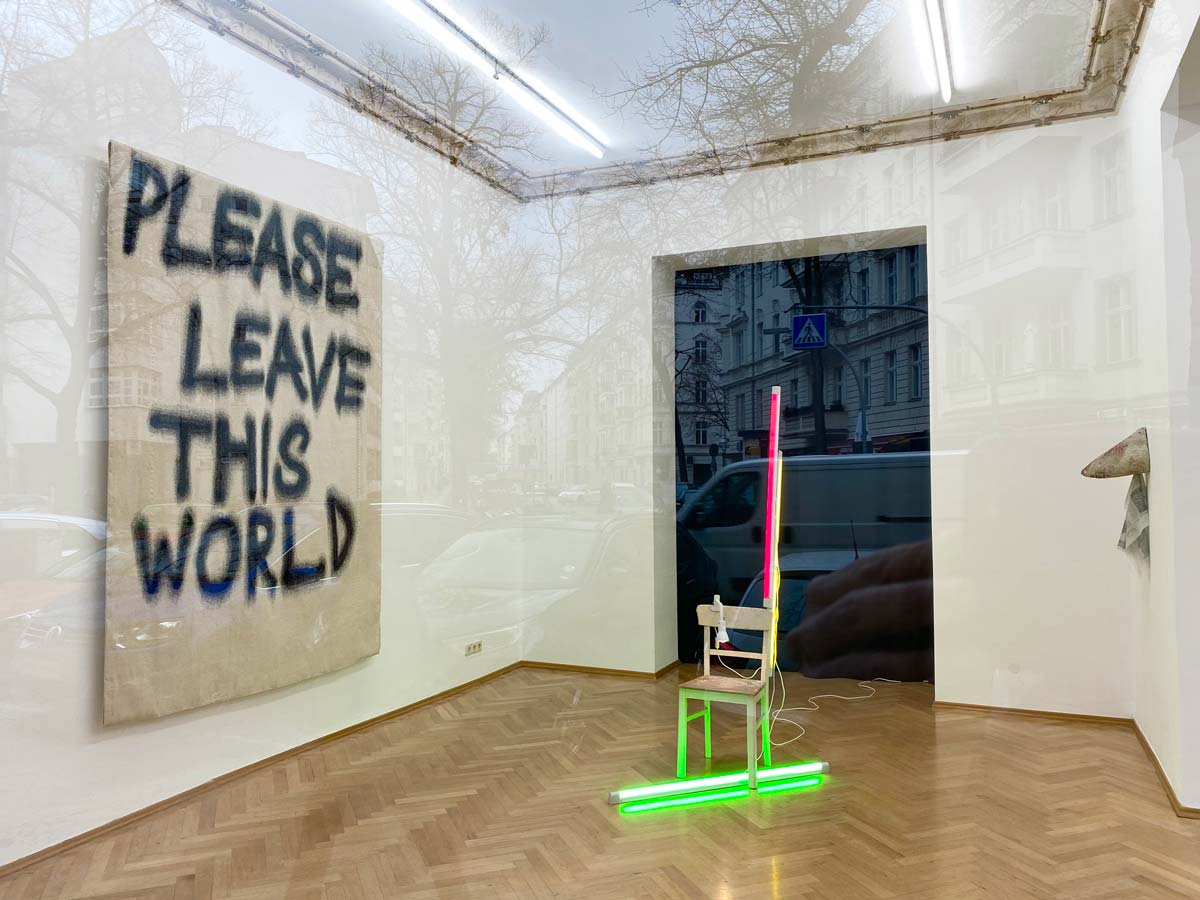
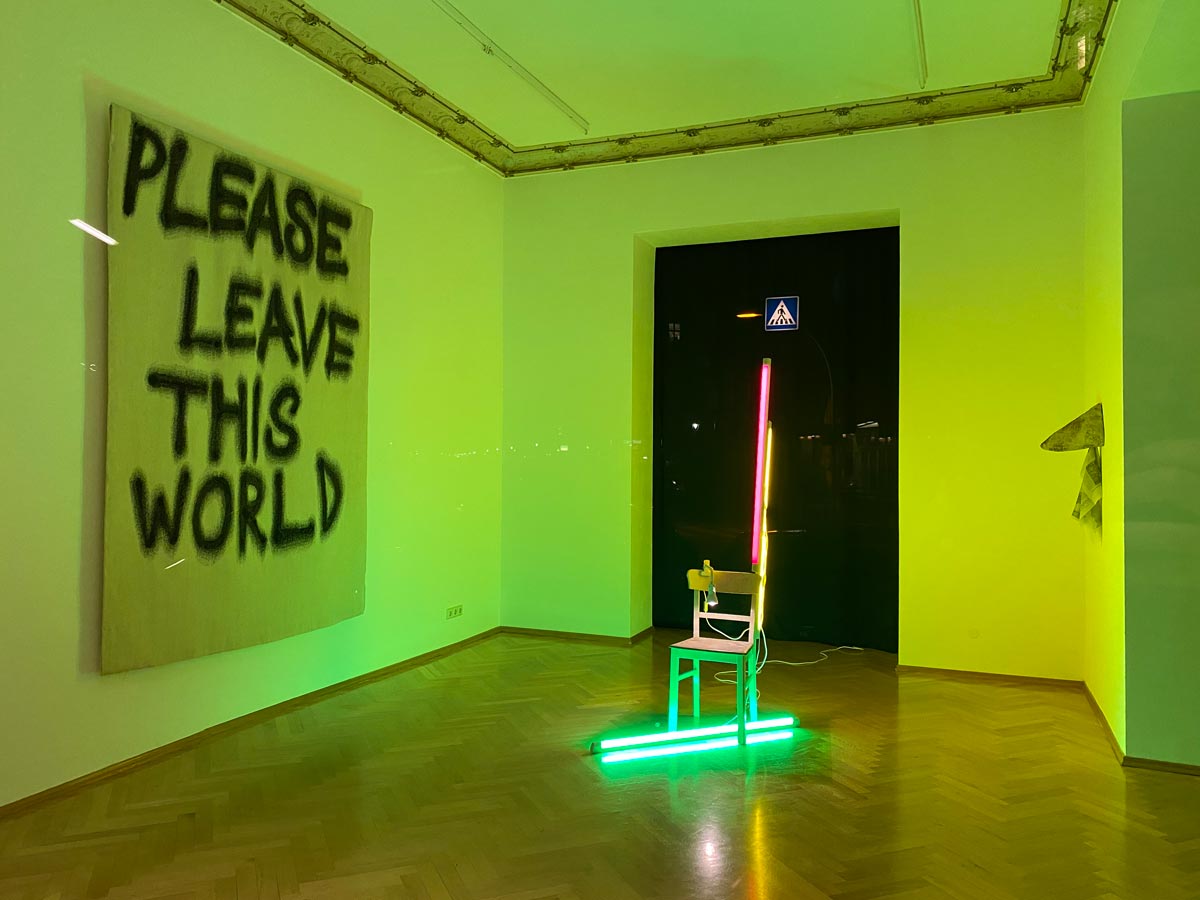
(english version below)
Interactions 4 stellt den mittels künstlicher Intelligenz erstellten Fotografien, Text- und Videoarbeiten von Ornella Fieres drei Arbeiten von John Isaacs gegenüber: einen handgewebten Gobelin mit dem Schriftzug PLEASE LEAVE THIS WORLD, eine Keramiknase als Wandskulptur, aus deren Öffnung ein mit der Titelseite einer Zeitung bedrucktes Seidentuch hängt, sowie eine Installation, bestehend aus einem alten Küchenstuhl, drei Leuchtstoffröhren und einer Klemmlampe. Beide Künstler thematisieren die Spuren menschlicher Kommunikation, das Verhältnis von An- und Abwesenheit sowie das Phänomen der Zeit; Themen also, die in Zeiten der Pandemie mit neuen Bedeutungen aufgeladen werden.
Zentral im Raum steht ein abgenutzter Küchenstuhl, an dessen Lehne eine weiße Lampe klemmt, welche die Sitzfläche beleuchtet. An einem zur Lehne hin verlängerten Stuhlbein sind eine rote und eine gelbe Leuchtstoffröhre befestigt, die Stuhlbein und Lehne nach oben hin verlängern; eine grüne Röhre liegt diagonal unter dem Stuhl. Pandemiegeleitet lässt der leere Stuhl an das Ausbleiben jener Nächte denken, in denen wir uns mit Freunden eng um einen Küchentisch versammelten. Die bunten Leuchtstoffröhren wiederum erinnern an verlassene Innenstädte und ehemalige Orte der Unterhaltung. Vergangenes wird heraufbeschworen. Dennoch hat die Installation – wie fast alle Arbeiten Isaacs’ – auch etwas lustig Unbekümmertes, fast als wollte sie zu uns zurufen: „Noch sind die Lichter nicht aus – das wird schon wieder!“
Während der Stuhl verlassen im Raum steht, fordert der Spruch auf dem Gobelin erst dazu auf: PLEASE LEAVE THIS WORLD. Offen bleibt, wer Bittsteller und wer Adressat des dringenden Wunsches sind, schleunigst zu verschwinden. Auch hier müssen wir an das Virus denken. Die Arbeit ist aber bereits 2016 entstanden. Eine Spannung entsteht dadurch, dass der Schriftzug aussieht wie schnell gesprüht, tatsächlich aber handgeknüpft ist. Zwischen Wunsch und Ausdruck vergingen somit Monate. Möglicherweise ist der Adressat also bereits verschwunden, wie auch die Person von der Sitzfläche des Stuhls, der noch immer beleuchtet wird, als würde man nach einem Anwesenden suchen.
Auch die dritte Skulptur mit dem Titel I know now what I knew before verbindet Text und Textil. Aus der Öffnung einer langen Terrakottanase hängt ein Tuch, das mit der Titelseite der New York Times bedruckt ist. Der Titel der Arbeit beschreibt dabei einen zutreffenden Sachverhalt: Wir konnten es vorher wissen. Die Arbeit entstand im Jahr vor dem Pandemieausbruch. Dabei bleibt offen, ob die Nase Neuigkeiten wie eine Droge in sich zieht oder ob der imaginäre Träger der Nase diese bereits voll davon hat.
Jedenfalls dreht sich in den Arbeiten alles um An- und Abwesenheit, Kommunikation und Information sowie die Zeit dazwischen. Auch Ornella Fieres beschwört in ihren Arbeiten das Abwesende. Die Arbeiten basieren auf einem Konvolut nachgelassener Briefe, darunter Postkarten und Fotografien, gerichtet an eine Frau aus Ost-Berlin. Fieres ließ die Texte von einer künstlichen Intelligenz transkribieren. Über hundert Textfragmente werden auf einem Monitor gezeigt, wobei eine KI-generierte Stimme diese zu Gehör bringt. In einer zweiten Werkgruppe ließ Fieres die Bildgegenstände der Fotografien KI-basiert beschreiben. Collagen zeigen die Rückseite der Originalabzüge und darunter die Bildbeschreibung. In der dritten Werkgruppe speiste die Künstlerin ein neuronales Netz mit Blumenmotiven der Postkarten aus dem Konvolut. Damit generierte Fieres mittels künstlicher Intelligenz neue Bilder von eigentümlicher Schönheit.
Sowohl die Arbeiten von Fieres wie auch die von Isaacs verweisen auf Abwesendes und untersuchen verschiedene Formen der Kommunikation. Beide Positionen evozieren eine Beschäftigung mit der Vergangenheit und verweisen auf eine (mögliche) Wiederkehr. In der Pandemie werden diese Themen mit gesteigerter Sensibilität wahrgenommen. Auf die – betrachtet man den leeren Stuhl – bereits erfüllte Forderung PLEASE LEAVE THIS WORLD antwortet ein von Fieres gezeigter Text: Es ist ein Jammer, daß wir uns nicht einmal wiedersehen konnten. So bleibt nur, das Abwesende wieder heraufzubeschwören. Mit den Mitteln der Kunst.
Interactions 4 juxtaposes Ornella Fieres’ artificial intelligence photographs, text and video works with three works by John Isaacs: a hand-woven tapestry with the inscription PLEASE LEAVE THIS WORLD, a ceramic nose as a wall sculpture from whose nostril hangs a silk cloth printed with the front page of a newspaper, and an installation consisting of an old kitchen chair, three fluorescent lights and a clamp lamp. Both artists thematise the traces of human communication, the relationship between presence and absence, and the phenomenon of time; themes, that are charged with new meanings in times of a pandemic.
In the centre of the gallery stands a worn kitchen chair with a small white lamp clamped to its backrest, illuminating the seat. A red and a yellow fluorescent light are attached to a chair leg extending the chair leg and backrest upwards; a green light lies diagonally below the chair. In the context of the pandemic, the empty chair makes us think of the absence of those nights when we gathered closely around a kitchen table with friends. The colourful fluorescent lights, on the other hand, remind us of abandoned city centers and former places of entertainment. The past is evoked. Nevertheless, the installation – like almost all of Isaacs’ works – also has something amusingly carefree about it, almost as if it wants to call out to us: “The lights aren’t out yet – it’ll be all right!”
While the chair stands abandoned in the room, the sentence on the tapestry first invites us to: PLEASE LEAVE THIS WORLD. It remains open who is the supplicant and who is the addressee of the urgent wish to leave as soon as possible. Here, too, we have to think of the virus. But the work was already created in 2016. A tension is created by the fact that the letters look like they were quickly sprayed, but are actually hand-knotted. Therefore month passed between the wish and the expression and it is possible that the addressee has already disappeared, as has the person from the seat of the chair, which is still illuminated as if looking for someone present.
The third sculpture, titled I know now what I knew before, also combines text and textile. A silk handkerchief printed with the front page of the New York Times hangs from the nostril of a long terracotta nose. The title of the work describes an accurate fact: we knew before. The work was created in the year before the pandemic outbreak. It remains open whether the nose absorbs news like a drug or whether the imaginary wearer of the nose is already fed up with it. In any case, the works are all about presence and absence, communication and information, and the time in between. Ornella Fieres also evokes the absent in her works. The works are based on a bundle of letters left behind, including postcards and photographs, addressed to a woman living in East Berlin. Fieres had the texts transcribed by an artificial intelligence. Over a hundred text fragments are shown on a monitor, with an AI-generated voice making them heard. In a second group of works, Fieres had the pictorial objects of the photographs described AI-based. Collages show the back of the original prints with the image description underneath. In the third group of works, the artist fed a neural network with floral motifs from the postcards in the collection. In this way, Fieres generated new images of peculiar beauty by means of artificial intelligence.
Both Fieres’ and Isaacs’ works refer to the absent and investigate various forms of communication. Both positions evoke a preoccupation with the past and refer to a (possible) return. In the context of a pandemic, these themes are perceived with heightened sensitivity. A text shown by Fieres responds to the – if one looks at the empty chair – already fulfilled demand PLEASE LEAVE THIS WORLD: It is a pity that we could not even see each other again. Through art what remains is the conjured sense of absence.

